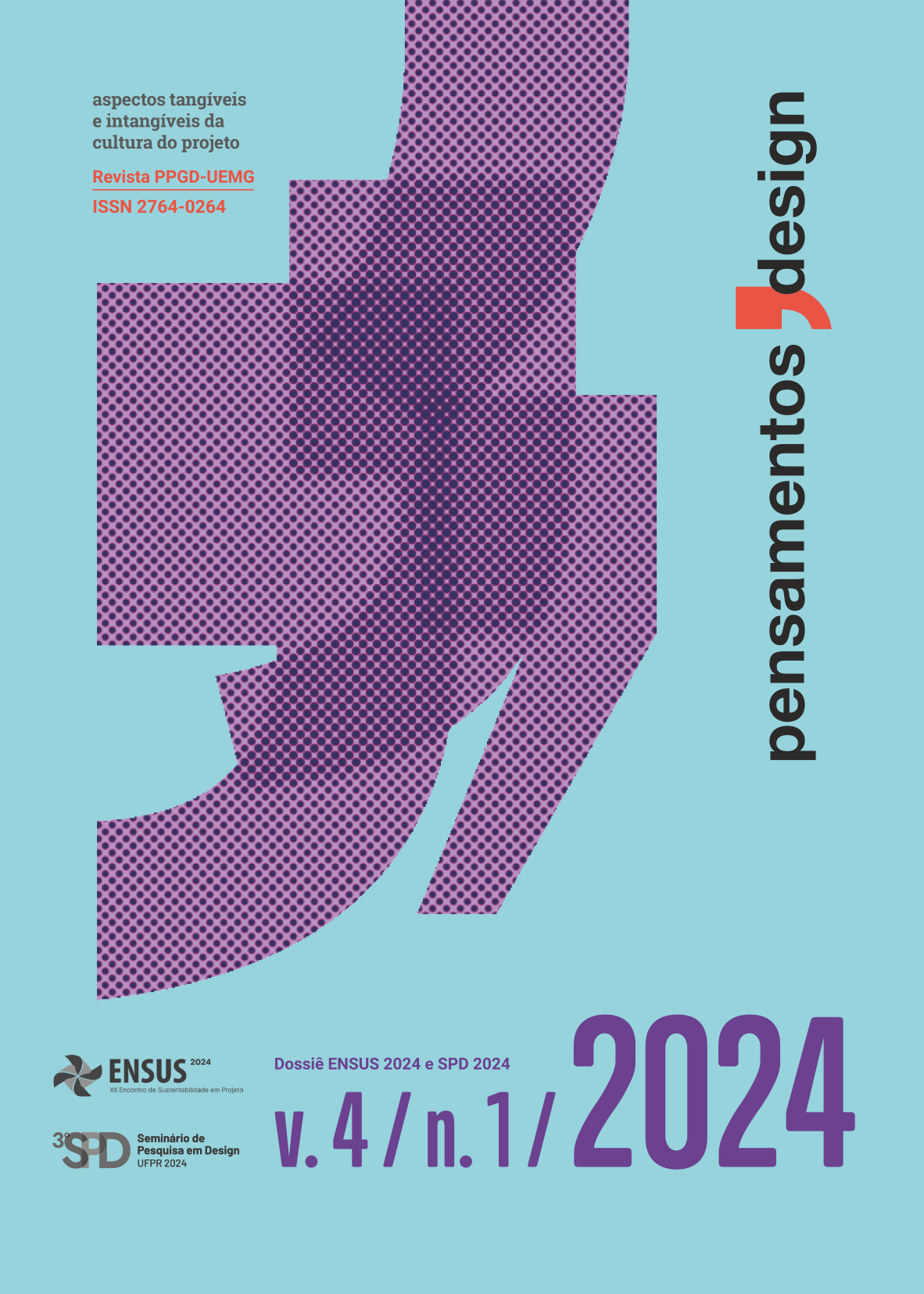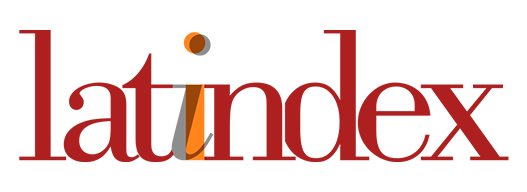The attitude towards other species in biodesign: an analysis of different frameworks
Visualizações: 55DOI:
https://doi.org/10.36704/pendes.v4i1.8923Palavras-chave:
biodesign, design with non-human living beings, frameworksResumo
Biodesign refers to, among other things, the design with other living organisms and systems. This paper aims to reflect upon and discuss humans' relationships with other species in biodesign - drawing on the analysis of existing frameworks that organise it. The questions that drive the discussion are: (I) What are the biodesign organising frameworks? and (II) What do these frameworks say about how humans relate to other species in biodesign? Seven frameworks were analysed, resulting from systematic and narrative literature reviews. The analysis reveals different attitudes towards other species. We argue that biodesign might not be a collaboration. This is an expanded version of an XI ENSUS 2024 conference paper.
Referências
ATTIAS, N.; DANAI, O.; ABITBOL, T.; et al. Mycelium bio-composites in industrial design and architecture: Comparative review and experimental analysis. Journal of Cleaner Production, v. 246, p. 1-17, fev. 2020. Doi. 10.1016/j.jclepro.2019.11903.
BERNABEI, R., POWER, J. Living Designs. In: INTERNATIONAL CONFERENCE, LIVING MACHINES, 5., 2016, Edinburgh. Anais […]. Edinburgh: 2016. p. 40-47. DOI. 10.1007/978-3-319-42417-0_4.
BIODESIGN CHALLENGE - BDC. Biodesign Challenge Summit 2021 — Day 1, 2021. 1 vídeo (5h 40min 20s). Disponível em: https://www.youtube.com/watch?v=cr8lYJmvLp0&t=6392s. Acesso em: 13 set. 2021.
CAMERE, S.; KARANA, E. Fabricating materials from living organisms: An emerging design practice. Journal of Cleaner Production, v. 186, p. 570–584, jun. 2018. DOI. 10.1016/j.jclepro.2018.03.081.
CAMERE, S.; KARANA, E. Growing materials for product design. In: ALIVE. ACTIVE. ADAPTIVE: INTERNATIONAL CONFERENCE ON EXPERIENTIAL KNOWLEDGE AND EMERGING MATERIALS, EKSIG 2017, Delft. Anais [...]. Delft: Delft University of Technology, 2017. p.101–115.
COHEN, N.; SICHER, E.; YAVUZ, S. U. Designing with microbial cellulose to feed new biological cycles. International Journal of Food Design, v. 4, n. 2, p. 155–171, mai. 2019. DOI. 10.1386/ijfd_00003_1.
COLLET, C. Alive, new design frontiers catalogue. Paris: Fondation EDF, 2013. Exhibition Catalogue.
COLLET, C. Biodesign. 2020a. Disponível em: < https://ext.maat.pt/bulletin/biodesign>. Acesso em: 04 abr. 2024.
COLLET, C. Designing our future bio-materiality. AI and Society, v. 36, p. 1331-1342, set. 2020b. DOI. 10.1007/s00146-020-01013-y.
COLLET, C. 'Grow-made' textiles. In: ALIVE. ACTIVE. ADAPTIVE: INTERNATIONAL CONFERENCE ON EXPERIENTIAL KNOWLEDGE AND EMERGING MATERIALS, EKSIG 2017, Delft. Anais [...]. Delft: Delft University of Technology, 2017. p. 24-37.
DADE-ROBERTSON, M. Living Construction. New York: Routledge. 2021a.
DADE-ROBERTSON, M. (Ed.). CITYX VENICE - Martyn Dade-Robertson: Can We Grow A City?, 2021b. 1 vídeo (duração desconhecida). Disponível em: https://www.youtube.com/watch?v=eGa4Mm6aLkY. Acesso em: 09 set. 2021
DESIGN MUSEUM. Design with the Living 2020. Disponível em: https://designmuseum.org/whats-on/talks-courses-and-workshops/design-with-the-living-2020. Acesso em: 4 mai. 2021.
DEW, K. N.; ROSNER, D. K. Lessons from the woodshop: Cultivating design with living materials. In: CONFERENCE ON HUMAN FACTORS IN COMPUTING SYSTEMS, 2018, Montreal. Anais [...]. Montreal: Association for Computing Machinery, 2018. p. 1-12. DOI. 10.1145/3173574.3174159.
FULLGROWN. About us. Available at: < https://fullgrown.co.uk/about-us-full-grown/>, Acesso em: 17 mai. 2021.
GINSBERG, A. D.; CALVERT, J.; SCHYFTER, P.; ELFICK, A.; ENDY, D. Synthetic Aesthetics: Investigating Synthetic Biology’s Designs on Nature. Cambridge: MIT Press, 2014.
GOUGH, P.; PSCHETZ, L.; AHMADPOUR, N.; et al. The nature of biodesigned systems: Directions for HCI. In: DIS '20: DESIGNING INTERACTIVE SYSTEMS CONFERENCE 2020, Eindhoven. Anais[...]. Eindhoven: Association for Computing Machinery, 2020. p. 389–392. DOI. 10.1145/3393914.3395908.
GRUSHKIN, D. What is Biodesign? Issues in Science and Technology. June 2021. Disponível em: https://issues.org/biodesign-challenge-synthetic-biology-grushkin/ . Acesso em: 13 set. 2021.
HEEMANN, A.; LIMA, P. J. V. ; CORREA, J. S. Fundamentos para o Alcance da Colaboração em Design. Estudos em Design (online), v. 18, n.2, p. 1338-1349, 2010.
KEUNE, S. Co–designing with plants. Degrading as an overlooked potential for interior aesthetics based on textile structures. Design Journal, v. 20, n. sup1, p. S4742–S4744, 2017a. DOI.10.1080/14606925.2017.1352977.
KEUNE, S. Transforming textile expressions by using plants to integrate growth, wilderness and decay into textile structures for interior In: ALIVE. ACTIVE. ADAPTIVE: INTERNATIONAL CONFERENCE ON EXPERIENTIAL KNOWLEDGE AND EMERGING MATERIALS, EKSIG 2017, Delft. Anais [...]. Delft: Delft University of Technology, 2017b. p. 90-100.
KERA, D. Innovation regimes based on collaborative and global tinkering: Synthetic biology and nanotechnology in the hackerspaces. Technology in Society, v. 37, n. 1, p. 28–37, 2014. DOI. 10.1016/j.techsoc.2013.07.004.
KIRDÖK, O., ALTUN, T.D., DOKGÖZ, D., TOKUÇ, A. Biodesign as an innovative tool to decrease construction induced carbon emissions in the environment. International Journal of Global Warming, v. 19, n.1-2, p. 127-144, 2019. DOI. 10.1504/IJGW.2019.10023357.
MANCUSO. S. A Revolução das Plantas. São Paulo: Ubu. 2019.
MELKOZERNOV, A. N.; SORENSEN, V. What drives bio-art in the twenty-first century? Sources of innovations and cultural implications in bio-art/biodesign and biotechnology. AI and Society, v. 36, p. 1313–1321.,2020. DOI. 0.1007/s00146-020-00940-0.
METCALFE, D. J. Multispecies Design. 206p.Tese (Doutorado) - University of Arts London e Falmouth University, Londres, 2015.
MYERS, W. Biodesign. Nature, science, creativity. High Holborn: Thames & Hudson, 2018.
OXMAN, N. Templating design for biology and biology for design. Architectural Design, v. 85, n. 5, p. 100–107, 2015. DOI. 10.1002/ad.1961.
PARISI, S.; ROGNOLI, V. Tinkering with Mycelium. A case study. In: ALIVE. ACTIVE. ADAPTIVE: INTERNATIONAL CONFERENCE ON EXPERIENTIAL KNOWLEDGE AND EMERGING MATERIALS, EKSIG 2017, Delft. Anais [...]. Delft: Delft University of Technology, 2017. p.66–78.
PATARANUTAPORN, P.; INGALLS, T.; FINN, E. Biological HCI: Towards integrative interfaces between people, computer, and biological materials. In: CHI EA '18: CONFERENCE ON HUMAN FACTORS IN COMPUTING SYSTEMS, 2018, Montreal. Anais[…]. 2018. Montreal: Association for Computing Machinery, 2018. p. 1–6. DOI. 10.1145/3170427.3188662.
POLITES, M. The Rise of Biodesign: Contemporary Research - Methodologies for Nature-inspired Design in China. Shanghai: Tongji University Press Co., Ltd, .2019.
STROBEL DO NASCIMENTO, E. Design with the Living: Learning to Work Together. 2023. 332p. Tese (Doutorado em Design) – Programa de Pós-Graduação em Design, Departamento de Design, Universidade Federal do Paraná, Curitiba, 2023.
TAMMINEN, S.; VERMEULEN, N. Bio-objects: new conjugations of the living. Sociologias, n.50, p. 156-179, 2019. DOI. 10.1590/15174522-02105005.
UNIVERSITY OF ARTS LONDON (UAL). Master of Arts in Biodesign. Disponível em: https://www.arts.ac.uk/subjects/textiles-and-materials/postgraduate/ma-biodesign-csm#course-summary . Acesso em: 12 jul. 2022.
VETTIER, L. Biodesign, comment penser la production avec le vivant? Philosophical Readings, v. 11, n. 1, p. 26–32, 2019. DOI. 10.5281/zenodo.2528435.
WEBER. R. About teaching and learning biodesign. Berlin, 23 jan. 2023. Entrevista.
YOCK, P. G.; ZENIOS, S.; MAKOWER, J. (Eds.). Biodesign: The Process of Innovating Medical Technologies. 2. ed. Cambridge: Cambridge University Press, 2015.
Downloads
- PDF | EN 32
Publicado
Como Citar
Edição
Seção
Licença
Copyright (c) 2024 Pensamentos em Design

Este trabalho está licenciado sob uma licença Creative Commons Attribution-NonCommercial 4.0 International License.
Autores que publicam na Revista Pensamentos em Design concordam com os seguintes termos:
- Autores mantém os direitos autorais e concedem à revista o direito de primeira publicação, com o trabalho simultaneamente licenciado sob a Licença Creative Commons Attribution que permite o compartilhamento do trabalho com reconhecimento da autoria e publicação inicial nesta revista.
- Autores têm autorização para assumir contratos adicionais separadamente, para distribuição não-exclusiva da versão do trabalho publicada nesta revista (ex.: publicar em repositório institucional ou como capítulo de livro), com reconhecimento de autoria e publicação inicial nesta revista.
- Autores têm permissão e são estimulados a publicar e distribuir seu trabalho online (ex.: em repositórios institucionais ou na sua página pessoal) a qualquer ponto antes ou durante o processo editorial, já que isso pode gerar alterações produtivas, bem como aumentar o impacto e a citação do trabalho publicado.
Dados de financiamento
-
Coordenação de Aperfeiçoamento de Pessoal de Nível Superior
Números do Financiamento 001









